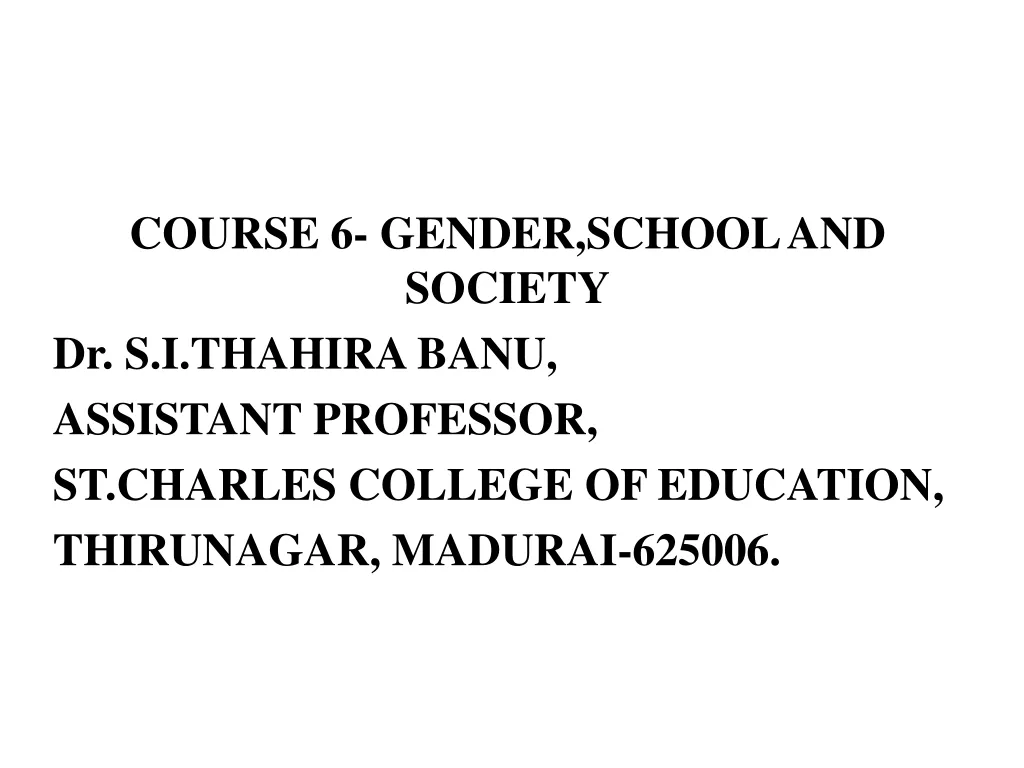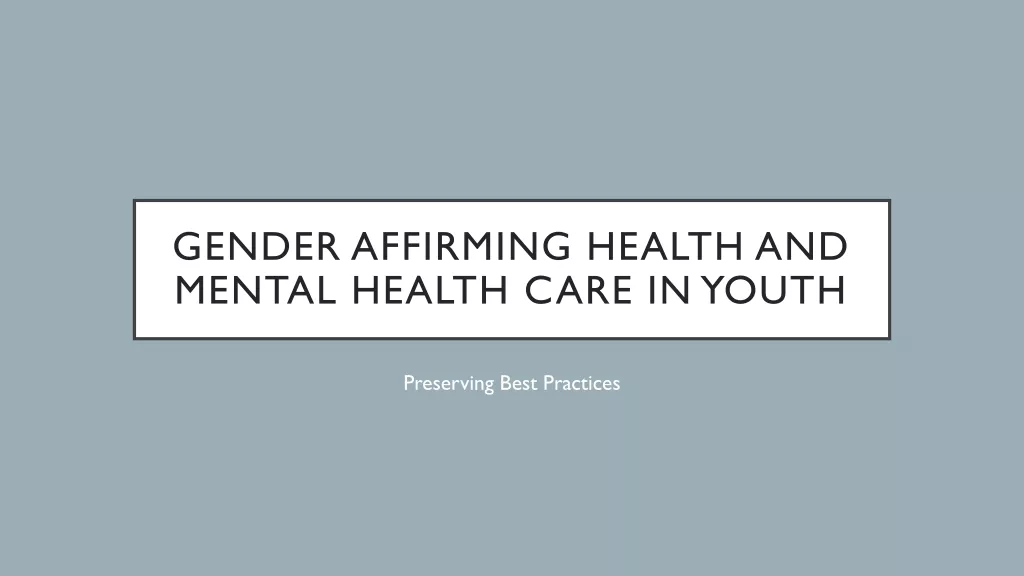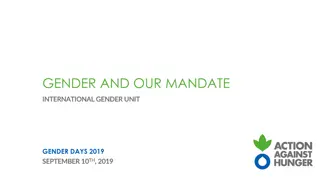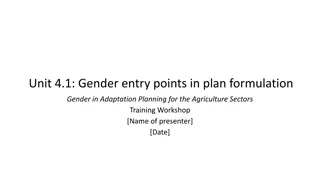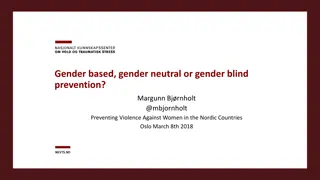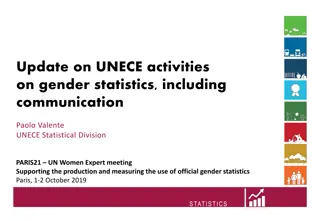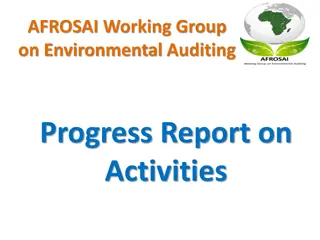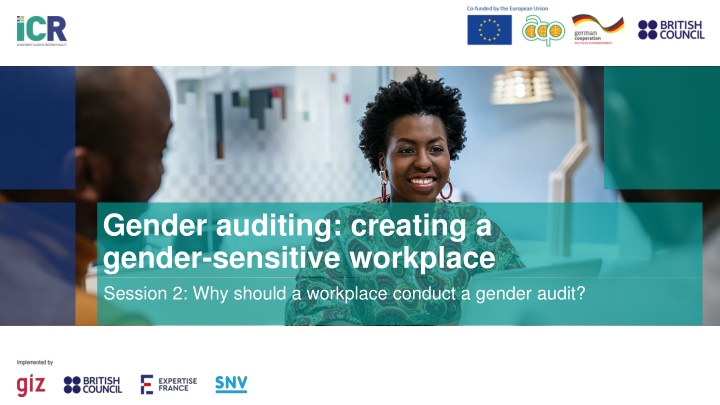
Gender Audit Impact on Workplace Equality
Explore the importance of gender audits in creating a gender-sensitive workplace and understand the legal, regulatory, and societal factors affecting women in employment. Dive into key findings revealing gender disparities and issues faced by women in the workforce.
Download Presentation

Please find below an Image/Link to download the presentation.
The content on the website is provided AS IS for your information and personal use only. It may not be sold, licensed, or shared on other websites without obtaining consent from the author. If you encounter any issues during the download, it is possible that the publisher has removed the file from their server.
You are allowed to download the files provided on this website for personal or commercial use, subject to the condition that they are used lawfully. All files are the property of their respective owners.
The content on the website is provided AS IS for your information and personal use only. It may not be sold, licensed, or shared on other websites without obtaining consent from the author.
E N D
Presentation Transcript
Gender auditing: creating a gender-sensitive workplace Session 2: Why should a workplace conduct a gender audit?
How the legal and regulatory environment affects women in employment Laws and regulations Absence of laws Social norms about gender roles Gendered sectors Organisational bias Caregiving and domestic responsibilities Family support (parental leave, childcare, etc.) Lack of facilities for women employees 2
Learnings from the Gender Audit in the Workplace Malawi Methodology Desk research on the country context, regulatory and policy environment that affects gender issues in the workplace. Review of national statistics, case studies, international reports Mapping of relevant stakeholders and organisations for whom gender issues are of direct relevance Data collection: information sessions, focus group discussions, and key informant interviews with stakeholders from government, NGOs and private sector Surveys of HR professionals, of micro and small enterprises, and of employees 3
Key findings: womens participation in the workforce Fewer women are employed in Malawi s labour force than men, and women experience more unemployment than men. Women are underrepresented in managerial and decision-making positions. Women are more likely to be self-employed, in precarious employment or in the informal sector. Women are time poor as they are responsible for the majority of unpaid care work and domestic responsibilities. Women earn less than men, partly because men occupy more senior positions, but also because there is pay-related discrimination in some workplaces. An estimated 37.5% of women are subject to gender-based violence in their lifetime; a significant minority of women experience this in the workplace. 4
Key findings: gender-based issues in the workplace One-third of women surveyed experienced sexual harassment or assault in the workplace. Just under half of respondents to the employee survey had been subject to discrimination in the workplace. Workplaces appear to under-estimate the prevalence of gender-based discrimination, harassment and abuse. Employees were more likely to highlight discrimination accessing promotion rather than being hired. Around 5% of employees and workplaces highlighted discrimination due to pregnancy. Only 21% of employees surveyed who had experienced discrimination reported it to their workplace, and 8% reported it outside their workplace. At least 40% of women who had experienced discrimination or harassment took no action or left their job. One quarter of complaints were investigated, and more than 20% of incidents that were reported were not acted upon. Less than one in ten workplaces highlighted lower pay for women as an issue. However, one third of the women from the employee survey highlighted a problem with pay. This is a particular concern in the agricultural sector. 5
Key findings: workplace responses to gender-based issues One-third of mid to larger sized companies, and 14% of micro and smaller enterprises had undertaken a gender audit; the majority were internal audits. Larger companies are more likely to have policies for gender equality and to target sexual harassment and gender-based violence. Some of the mid to larger companies surveyed offered flexible working for women employees but this was much less common in the micro and small enterprises. The majority of workplaces felt they were doing a good job in dealing with gender issues. But only a minority of surveyed employees had confidence in their workplace s ability to deal with gender issues, with 17% indicating they felt unsafe at work. 40% of instances of harassment were perpetrated by a superior at work. Despite some innovative actions to combat sexual harassment, there is still a significant lack of clarity about how to recognise and deal with this issue in many workplaces. 6
Key findings: the impact of gender inequality in the workplace Gender inequality has a negative economic impact on companies, communities and countries. Sexual harassment has a negative psychological impact on those who both experience and witness it. The most significant organisational impacts identified by the mid-to-larger companies surveyed were cost increases and higher levels of staff turnover. The micro and very small enterprises surveyed found gender-based discrimination and harassment had an impact on work climate, absenteeism, staff turnover and profitability. Employees perceive an impact on work culture. It is possible that companies underestimate the impact of gender inequalities and inappropriate behaviour in the workplace, as only limited systematic analyses of the consequences have been carried out. 7
Examples of good practice in workplaces Fostering equality and opportunities for women Set clear gender targets. Find creative ways to achieve those targets. Embed gender policies and targets into organisational consciousness. Encourage a mindset shift. Create family-friendly policies to address caring responsibilities. Use mentoring to help women build networks. Aim for a systematic approach to gender equality. 8
Examples of good practice in workplaces (cont.) Eliminating harassment and violence in the workplace Ensure staff and suppliers recognise harassment and violence in the workplace and know how to respond. Develop policies and processes that will ensure anonymity. Keep improving and try to learn from other parts of the organisation. 9
Recommendations for policymakers 1. Accompany legal and regulatory changes with commitment, capacity and resources Malawi has a sound legal and regulatory basis for establishing and maintaining gender equality and for eliminating gender-based discrimination, harassment and violence. Nonetheless, additional efforts are needed. 2. Review the currently ending policy cycle and create a future-proof action plan 3. Address socio-cultural issues that shape education and career choices of girls and women Cultural norms are often unconscious, and in Malawi, largely considered to be a patriarchal society, this has led to some deeply entrenched inequalities, which in turn have influenced the current patterns of women s employment as well as a range of inequalities and presence of harassment. 10
Recommendations for workplaces 1. Foster greater equality in the workplace A strong commitment to gender equality by leaders is key to success. Top-level commitment must be accompanied by assigning responsibility and ensuring accountability throughout organisations. Organisations extending gender policies beyond organisational boundaries can become multipliers for change. 11
Recommendations for workplaces (cont.) 2. Eliminate harassment and gender-based violence Accompany awareness and understanding with a zero-tolerance stance towards harassment and gender-based violence. Understand how to recognise sexual harassment. Foster an open culture to raise awareness of harassment and gender-based violence. Support victims throughout the process of making a complaint about harassment or gender-based violence Improve data collection relating to allegations of discrimination and harassment. 12

